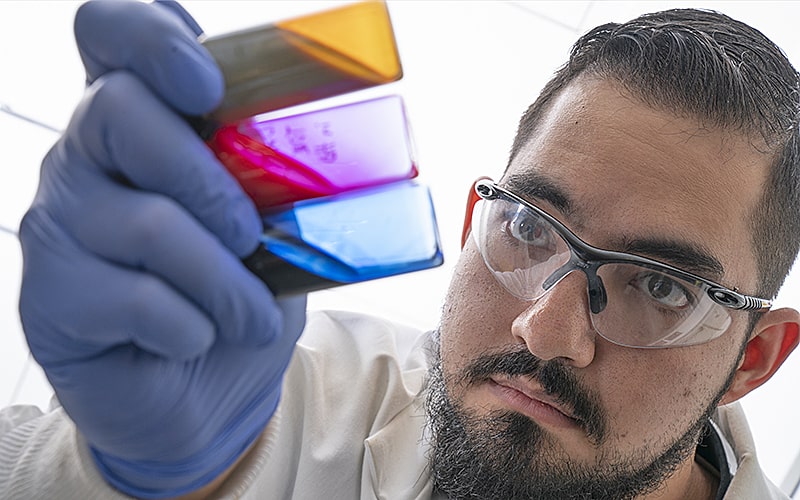
Nanotechnology

With our long history in heterogeneous catalysis and surface science, Michigan chemical engineers have been using nanotechnology well before it became a buzzword. New tools allow even better control of nanoparticle growth, shape and properties – and better characterization of the final products. We are developing nanotubes, nanoprobes, nanomaterials, nanocatalysts and nanostructures for a variety of applications in energy conversion, medicine and electronics, for example. Our faculty and students apply both state-of-the-art experimental techniques and sophisticated computational approaches.
Sharon Glotzer
Professor Sharon Glotzer and her research group use computer simulation to discover the fundamental principles of how nanoscale building blocks can self-assemble and how to guide that process to engineer new materials. Her team develops the theory and molecular simulation tools to understand self-assembling, self-sensing and self-regulating materials.
Bryan Goldsmith
Professor Goldsmith and his research team use first-principles computational modeling and data analytics to understand various nanomaterials and nanoscale phenomena for natural gas conversion and sustainable applications. Some topics of interest include: supported nanoparticle and nanocluster disintegration and Ostwald ripening under reaction conditions; understanding nanoparticle growth, size, and shape effects; crystal structure and materials property prediction; using machine learning to help screen nanomaterials and find interpretative models.
Xiwen Gong
The Gong research group studies the surface chemistry and photophysics response of semiconducting nanomaterials. We interface nanomaterials with other emerging solution-processed materials, including perovskites, polymers, and organic semiconductors.We further transform the material innovation into bioelectronics devices for health monitoring, soft robotics, artificial intelligence, and beyond.
Jovan Kamcev
Professor Kamcev and his research group develop new microporous nano materials (porous aromatic frameworks, covalent organic frameworks, metal-organic frameworks) for water treatment and energy storage/generation applications.
Nicholas Kotov
Professor Nicholas Kotov and his research group study the self-organization of nanoparticles into more complex structures. These structures have promising applications in electronic devices and medicine, among other areas.
Mark Kushner
Professor Mark Kushner and his group develop computer-aided design software for etching nanostructures on surfaces using low temperatures plasmas. This software is used to improve the processing of microelectronics.
Computational Plasma Science and Engineering Group
Joerg Lahann
Professor Joerg Lahann’s research interest is focused on the development of active, multi-functional bio-interfaces, which are applicable to a range of biomedical applications. His group’s recent advances in the molecular design of active nanostructures include the introduction of reactive coatings, reversibly switching surfaces, and anisotropic nanoparticles that support the vision of smart interfaces and act as templates in time-controlled surface interactions.
Andrej Lenert
Professor Andrej Lenert and his team probe fundamental transport at the nanoscale by integrating optical and micro-fabricated platforms with environmental and thermal control
Rebecca Lindsey
Professor Lindsey’s group develops advanced simulation tools to establish a fundamental understanding of how chemistry mediates material behavior in extreme temperature/pressure environments and in complex systems. Her group leverages this new knowledge for material discovery and design, and to inform development of next-generation materials synthesis and manufacturing methods. Her group specializes in condensed phase simulation spanning quantum mechanical to coarse-grained scales, and artificial intelligence (e.g., machine learning) for efficient simulation and data-driven prediction.
Suljo Linic
Professor Suljo Linic’s lab members are currently working on a number of projects that aim to address various issues in the fields of energy and environment, functional nanomaterials, industrially-important reactions and fundamental heterogeneous catalysis.
Albert Liu
Arming nano-electronics with mobility extends artificial systems into traditionally inaccessible environments. Quantum-confined nanoparticles (0D), carbon nanotubes (1D), graphene (2D) and other crystalline materials with well-defined lattice structures can be incorporated into polymer microparticles (i.e., colloidal electronics), granting them unique electronic functions. The Liu laboratory seeks to advance device capabilities for individual colloidal electronic particles, and explores higher-order assemblies of these building-blocks into hierarchical colloidal electronic matter. This research program, positioned at the intersection between materials design, chemical catalysis, and electronic device fabrication, aims to address one central challenge: Can we build materials the way nature builds us?
Laboratory of Emergent and Galvanically Orchestrated Systems (LEGOS)
Jouha Min
James moon
The Moon Laboratory aims to develop novel therapeutics at the interface of immunology and engineering. Specifically, we are developing drug delivery systems designed to enhance delivery of antigen and adjuvant to lymphoid organs in the context of immunotherapies and vaccines.
Sunitha Nagrath
Professor Sunitha Nagrath research focus is the development of advanced MEMS tools for understanding cell trafficking in cancer through isolation, characterization and study of circulating cell in peripheral blood of cancer patients. These investigations will progress to the design and development of smart chips that use microfluidics and nanotechnology to make an impact in medicine and life sciences.
eranda nikolla
Professor Nikolla and her group focus on the development of synthesis methods for controlling the nanostructure of catalytic materials in order to achieve utmost efficiency of catalytic processes for energy conversion and storage.
Johannes Schwank
Professor Johannes Schwank and his research group develop new methods for synthesizing oxide nanotubes and nano-scale core-shell structures that harvest and utilize sunlight to produce hydrogen from water, convert carbon dioxide into fuels, and eliminate environmental pollutants.
Ashwin Shahani
Professor Shahani’s focus is on the processing-structure paradigm of materials science, with attention to the solidification dynamics of periodic and aperiodic crystals in metals and their alloys. His efforts have helped to reveal the interplay between small-scale patterns and the larger-scale macrostructures that will impact the properties of materials.
Lonnie Shea
Professor Lonnie Shea’s laboratory is developing nanoparticles for reprogramming immune cells for use in precision immunotherapies, with applications to autoimmune disease, allergies, transplant rejection and inflammation.
Max Shtein
Professor Max Shtein and his group are developing nanoprobes for discovering the energy landscape of surfaces. The technique could image the structures of biological cells or reveal ways to improve the efficiencies of solar cells and thermoelectric devices. The group is also studying how to guide the self-assembly of nanocrystals into solar cells.
Peter Tessier
Professor Peter Tessier and his group aim to develop next generation technologies for designing, discovering, engineering, characterizing, formulating and delivering monoclonal antibodies and other biologics for molecular imaging, diagnostic and therapeutic applications. Their research uses nanotechnology-based methods for i) discovering new antibodies and other therapeutic proteins, ii) identifying rare protein variants with drug-like properties for therapeutic applications, and iii) selecting formulation conditions that promote high protein stability and resistance to aggregation.
Anish Tuteja
Professor Anish Tuteja and his group are exploring methods to direct the self-assembly of nanoparticles into particular structures comprised of multiple types of polymer. By controlling the distribution of nanoparticles in the polymer, the team can tailor the electric, optical, and magnetic properties of the composite material.
The Polymers, Surfaces and Interactions (ψ) Group
Fei Wen
Professor Fei Wen ‘s group produces virus-like nanoparticles for improved vaccines and drug delivery strategies.